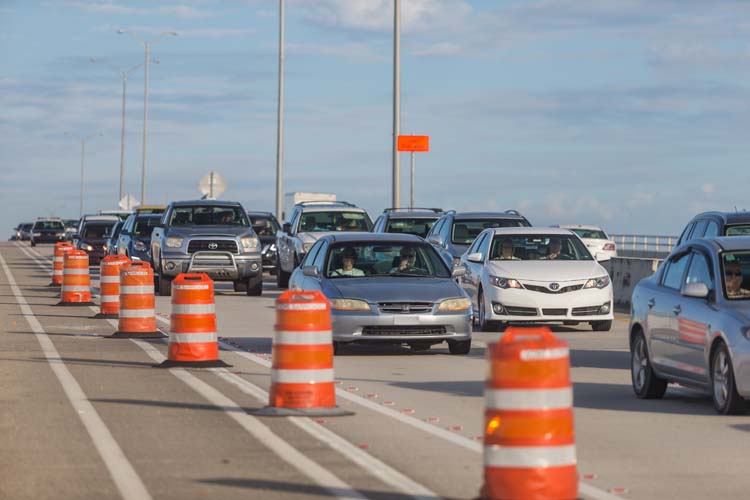
The four-year project to rebuild the crumbling 17th Street bridge across the Indian River Lagoon is off to a bad start – or rather, no start at all, since the work, originally slated to begin May 30, has now been postponed until at least September.
“We realize that September is the height of the hurricane season around here, so depending on what happens with the weather, there may be further delays of a few days,” said a site manager at the Vecellio & Grogan, Inc., the West Palm Beach-based contractor on the $22.3 million job, one of the largest bridge construction firms in the nation.
It seems like those oft-cited supply chain problems are the culprit for the latest delay on the 17th Street bridge work in Vero Beach.
“There were problems with materials acquisition, so the start has been postponed a bit,” said the manager. He asked that his name not be used, since all information on the project was supposed to come from the public relations firm hired by the Florida Department of Transportation, which failed to reply to several messages asking for information.
The four-year project had originally been scheduled to start May 30 of this year and run until the summer of 2027. It involves the complete replacement of the eastern (beachside) 400 feet of the bridge that has suffered the worst weather and water erosion damage, as well sealing the full 0.9 miles of the length of the bridge, improving signage and creating permanent new markers for bike lanes.
Because of the delay, the builders are missing the off-season summer months, when traffic is lighter in Vero Beach. That would have been an ideal time for lane closures, but now the builders will run smack into the busy winter season, likely causing more delays for weary motorists already reeling from several road construction projects along Highway A1A.
During the four years of the new construction project, the speed limit on the bridge will be reduced from 45 mph to 35 mph and the bridge will be subject to lane closures, with traffic limited to one lane in each direction most of the time.
At times the bridge, officially renamed the Alma Lee Loy bridge but still known to most as the 17th Street bridge, will be closed entirely, with traffic getting rerouted to the Merrill P. Barber Bridge. Those detours will be limited to nighttime hours between 9 p.m. and 7 a.m. Sunday through Thursday. Emergency vehicles en route to the Cleveland Clinic Indian River Hospital or other mainland facilities will be guaranteed access across the bridges at all times.
Construction will be divided into three phases. During Phase One, scheduled to take 960 working days, the north side of the bridge will be closed to traffic while motorists traveling between the mainland and the island will have one lane in each direction at their disposal on the south side.
During the 580-day Phase Two, the traffic pattern will switch, with the south side of the bridge being closed and north side open to traffic with one lane in each direction. The shorter Phase Three, scheduled to last only 60 days, involves road markings for a bike lane, railings and signage.
After the bridge, originally built in 1979, had been found to be “structurally deficient” with crumbling concrete and rusted cables by FDOT in 2019, temporary fixes were undertaken in 2020 which also involved alternating lane closures for several months. That part of the project had also suffered significant delays when a contractor went out of business and a new firm had to be found to complete the interim work.
Vero Beach residents seem to be largely resigned and inured to the traffic woes caused by constant FDOT road building projects that often extend beyond the original due dates. No elected public officials showed up at a May public information meeting at Vero Beach City Hall and only a couple of questions were asked of the FDOT officials present by video link.
Someone wanted to know, in view of the delay in the temporary fixes project of 2020, what measures had been taken to prevent similar delays in the final work phases. He was told that the contractor will face “significant disincentives if they’re late – there is a daily rate of penalties.” It is not known if the new delay has already triggered some of those penalties.
Another questioner wanted to know why it took only two years to build the original bridge from scratch and just rebuilding a 400-foot section of it will now take double the time – four years. The engineers on the project explained that the rebuilding is more complicated because the bridge now supports many utility lines and cables, which the original bridge did not, and which will now have to be moved first.
The work on moving the utility cables will be done first, which is why Phase One of the project is the longest. The utility lines will be relocated on temporary brackets away from the bridge to ensure no interruption of services to island residents. Additionally, there will be access at all times to all businesses and residences in the vicinity of the bridge work.
Engineers working on the project also gave assurances that boat traffic on the Intracoastal Waterway from Jacksonville to Miami will not be interrupted or impeded by bridge construction.



